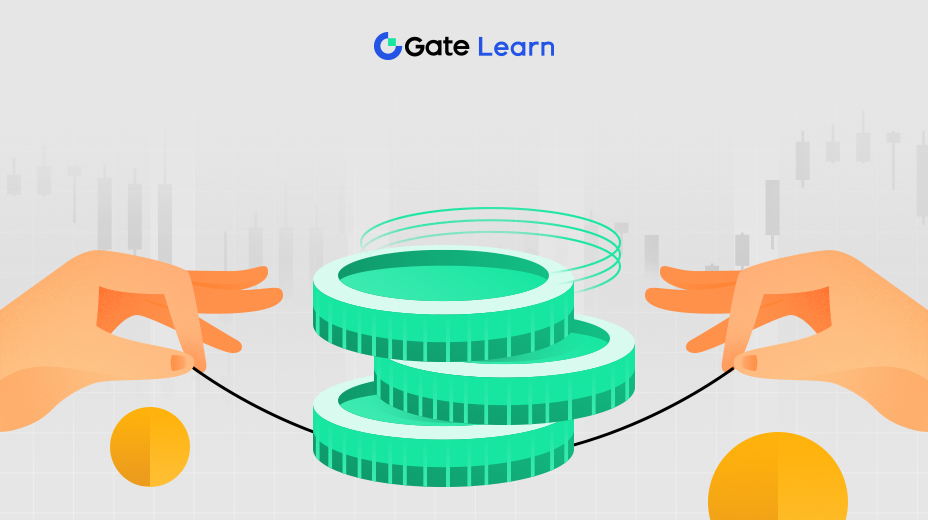加密货币衍生品介绍
本章将介绍加密货币衍生品的基础知识。我们将从加密货币衍生品的基本概念入手,分析它们是什么以及它们在传统金融中的作用。随后,我们将深入分析不同类型的加密货币衍生品,如期货、期权和掉期。我们还将重点介绍加密货币衍生品市场的主要参与者,如Gate.com,并分析加密货币衍生品的法律和监管环境,帮助你更加自信地掌握这个复杂的领域。
什么是衍生品?
衍生品是一种金融工具,其价值来源于标的资产。标的资产可以是任何东西,如石油和黄金等商品,或利率等金融指标,甚至是股票和债券等其他金融工具。“衍生品”一词来自于这些工具获取价值的方式。衍生品不具有内在价值,其价值基于(源自)另一项资产的价值。
衍生品本质上是两方或多方之间的合约。合约条款基于标的资产。合约对交易价格和日期等进行了规定,由相关各方共同商定,使参与者能够预测标的资产的未来价格,或对潜在价格变动进行套期保值。
为便于理解,我们来看一个期货合约形式的衍生品案例。假设一名小麦种植户担心未来小麦价格波动,他可以签订一个期货合约,在未来的某个日期以预定的价格出售小麦。这样种植户可以事先锁定价格,防止价格下跌。
另一方面,一家面包店想要确保未来有稳定的小麦供应,就可以签订同一个期货合约,同意在未来某个日期以预先确定的价格购买小麦。这样面包店便能够防范潜在的价格上涨。
期权是另一种常见的衍生品形式。期权合约赋予持有人在一定期限内以特定价格买入或卖出标的资产的权利,但并不强制执行这一权利。例如,交易者可以购买看涨期权,在未来六个月内以特定价格购买一只股票。如果股票价格在此期间大幅上涨,交易者可以行使期权,以较低的协议价格买入股票,并有可能获利。
掉期是另一种形式的衍生品,涉及与不同资产相关的现金流或其他变量的交换。最常见的掉期类型是利率掉期,其中一方用利息支付流交换另一方的现金流。
加密货币衍生品:一种新范式
加密货币衍生品与传统衍生品非常相似,是一种金融合约,其价值来自标的加密货币资产,如比特币或以太坊。加密货币衍生品代表了在未来某个时间以特定价格购买或出售该标的资产的协议,包括期货、期权和掉期,每种衍生品在市场上都有其独特的特点和用途。
加密货币衍生品的基本原则与传统衍生品相同。例如,加密货币期货合约代表在未来特定日期以预定价格购买或出售一定数量的加密货币的协议。合约买方同意在未来购买标的资产,而卖方则同意出售该标的资产。二者的区别在于交易的资产,于加密货币衍生品而言,交易的资产是加密货币,而非传统资产。
同样,加密货币期权为持有人提供了在一定期限内以特定价格购买(认购期权)或出售(认沽期权)一定数量的加密货币的权利,但不具有义务。与传统期权一样,加密货币期权可用于套期保值、投机或管理风险。
加密货币掉期的运作方式与传统货币类似,允许各方交换与不同加密货币相关的风险。一种常见的加密货币掉期是“永续掉期”,这是一种类似于传统期货合约但没有到期日的衍生产品。
加密货币衍生品的出现代表着加密货币市场的重大发展,它们为市场增加了流动性,为更多交易者提供了更高级的交易工具,使加密货币交易领域更加成熟。
然而,加密货币衍生品和传统衍生品之间也存在着差异。首先,与传统市场不同,加密货币市场7*24小时运作。也就是说,加密货币衍生品可以随时交易,可能导致更大的波动性。此外,标的资产(加密货币)本身具有高度波动性,可能会放大交易者的盈亏。
加密货币衍生品和传统衍生品的另一个重要区别是监管环境。虽然传统衍生品受到全球金融管理机构的监管,但加密货币衍生品存在于一个更加不确定和不断发展的监管环境中,可能为交易者和投资者带来机遇和风险。
加密货币衍生品的主要类型
加密货币期货是一种主要的加密货币衍生品,在运作方式上与传统金融市场的期货类似。通过签订期货合约,买方同意在预定日期以特定价格购买一定数量的加密货币。加密货币期货使交易者能够对加密货币未来价值进行投机,而无需实际拥有标的资产。加密货币期货可以以实物结算(资产交付)或现金结算(支付价格差额)。
期权是另一种常见的加密货币衍生品,是一种金融工具,赋予持有人以预定价格购买(认购期权)或出售(认沽期权)标的资产的权利,但不具有义务。这个价格被称为行权价格,在合约启动时设定,在合约到期前有效。期权可用于对价格上涨(通过购买认购期权)和价格下跌(通过购买认沽期权)进行投机。
美式期权和欧式期权是两种类型的加密货币衍生品。美式期权允许持有人在到期前随时行使期权,可以灵活地以特定价格买入或卖出期权。欧式期权则只能在到期时行使。虽然美式期权具有更大的灵活性,但欧式期权在风险管理方面具有优势。
在加密货币交易中,美式期权适用于期望市场频繁波动的积极交易者。他们可以在市场条件变化时提前行使期权。欧式期权适合那些追求长期稳定投资的投资者,因为它们只能在到期日行权,无法提前行使。在选择这两种期权时,交易者应充分考虑自己的投资目标和风险承受能力。
加密货币领域的掉期与传统金融市场的掉期类似,但以加密货币作为标的资产。在掉期协议中,双方同意在一定期限内交换现金流序列。加密货币掉期具有多种用途,包括对冲价格波动、投资不同的加密货币和管理风险。
永续掉期是一种独特的加密货币衍生品。这类合约类似于期货,但没有到期日。交易者可以无限期地持有头寸,只要他们能够支付每隔几小时在买方与卖方之间交换的资金利率。这种机制有助于使永续掉期价格接近标的资产的现货价格。
差价合约(CFD)是一种衍生产品,允许交易者在不拥有标的资产的情况下对加密货币的价格变动进行投机交易。CFD跟踪加密货币的价格,利润或亏损取决于合约的开仓价和平仓价之间的差额。需要注意的是,CFD是比较复杂的金融工具,由于杠杆作用,存在迅速亏损资金的高风险。
Gate.com:加密货币衍生品市场的主要参与者
Gate.com是加密货币衍生品市场值得关注的主要平台之一,成立于2013年,现已发展成为一个提供全方位服务的综合交易平台,包括现货交易、期货合约、保证金交易和质押。Gate.com在流动性和交易量方面一直稳居前十,是全球加密货币市场的重要参与者。
Gate.com拥有一个强大的期货交易平台,为用户提供了交易各种加密货币期货合约的机会,包括比特币、以太坊以及很多山寨币。平台提供了USDT永续合约和BTC永续合约两种选项,以及高达100倍的杠杆。高杠杆有可能使交易者获得可观的利润,但也可能产生更高的风险。
与期货一样,Gate.com永续合约允许交易者对加密货币的价格进行投机交易,但没有到期日。这非常适合于希望长期持有仓位而不必担心合约到期的交易者。Gate.com提供USDT和BTC两种永续合约,供交易者灵活选择。
Gate.com还以其用户友好的界面和强大的安全措施而闻名。平台的界面设计直观,简洁明了,既适合初学者,也适合经验丰富的交易员。此外,Gate.com高度重视安全性,实施了多种安全措施,包括双因素身份验证(2FA)、采用冷存储方式保存用户资金,以及用于检测和预防可疑活动的强大系统。
Gate.com交易所严格遵守世界各地的法规,实施了全面的KYC实名认证和反洗钱(AML)措施,以防止非法活动。对合规的关注提高了平台的可靠性和用户的信任,进一步巩固了其在加密货币衍生品市场的重要参与者地位。
除Gate.com等传统的中心化交易平台,去中心化金融(DeFi)领域其他专注于加密货币衍生品的重要项目,我们也将在本课程中一一介绍。
加密货币衍生品的法律和监管环境
加密货币衍生品的法律和监管环境相对复杂且在不断变化。由于加密货币衍生品是相对较新的金融工具,许多司法管辖区仍在制定和实施相关法规。
在美国,商品期货交易委员会(CFTC)负责监管期货和期权市场,也包括加密货币市场。CFTC一直积极监管加密货币衍生品市场,并对未能遵守其规定的平台采取执法行动。这些规定包括要求平台拥有必要的运营许可证,并遵守有关市场操纵和消费者保护的规定。
欧洲对加密货币衍生品的监管环境比较分散,不同的国家有不同的法规,但欧洲证券和市场管理局(ESMA)发布了关于加密货币衍生品的指导方针,表明加密货币衍生品应该像欧盟法律下的任何其他衍生品一样处理。也就是说,欧洲的加密货币衍生品平台需要遵守《金融工具市场法规》(MiFID II)和其他相关法规。
亚洲对加密货币衍生品的监管政策差异很大。一些司法管辖区(如日本和香港)对加密货币衍生品有明确的规定,还有一些司法管辖区(如中国)则完全禁止加密货币衍生品。在允许加密货币衍生品存在的司法管辖区,平台通常需要获得相关当局的许可,并遵守有关风险管理、反洗钱(AML)和实名认证(KYC)的规定。
自我监管组织(SRO)也在加密货币衍生品市场中发挥重要作用。SRO是行业主导的机构,负责制定和执行规则以促进市场的公平性与透明性。虽然SRO没有政府监管机构的法律权力,但它们在制定行业标准和最佳实践方面发挥着关键作用。
对于加密货币衍生品市场来说,监管并不一定是一件坏事。尽管监管实施了额外的要求和限制,但也有助于建立一个更加合法、稳定的市场,能够保护投资者,并防止欺诈和操纵。随着市场的不断成熟,良好的监管环境将使所有参与者收益。
总之,加密货币衍生品的法律和监管环境是复杂且不断变化的,不同司法管辖区之间存在显著差异。交易员和投资者应及时了解最新动态,并在不清楚相关法规的具体要求时寻求法律建议。
加密货币衍生品的好处和风险
加密货币衍生品为交易者和投资者提供了多个好处。首先,它可以用来对冲加密货币市场的极端波动。通过衍生品,交易者可以保护他们的投资免受突然价格变化的影响,并降低可能的损失。在加密货币市场这样波动性很高的市场中,衍生品尤其有用。
其次,加密货币衍生品创造了投机机会。交易者可以从价格波动中获利,而无需拥有标的加密货币。这可以提供一定程度的灵活性和金融杠杆,而直接投资加密货币则不具备这种优势。
第三,加密货币衍生品还可以提供较高的市场流动性。更多的交易选择和参与者意味着更强大和高效的市场。这可以使所有参与者(包括个人交易者和机构投资者)受益。
虽然加密货币衍生品具有以上优势,但也伴随着巨大的风险。标的加密货币的高波动性意味着损失与收益都可能被放大。这可能导致交易者在短时间内遭受重大损失。
围绕加密货币衍生品的监管不确定性是另一个主要风险。加密货币衍生品的法律和监管政策因司法管辖区而异,而且可能会迅速变化。这可能会给交易员和投资者带来意外的法律和财务挑战。
此外,在加密货币衍生品交易中,杠杆的使用是一把双刃剑。它在放大利润的同时,也可能放大损失。使用高杠杆的交易者可能导致超过其初始投资额的损失。
要投资加密货币衍生品,我们需要对加密货币市场和衍生品工具有深入的了解,否则,交易者很容易犯下代价高昂的错误。此外,虽然加密货币衍生品在不断进步,但交易加密货币衍生品的基础设施仍在发展中。技术故障、安全问题和其他操作风险可能会给交易者带来挑战。
最后,加密货币衍生品市场与整个加密货币市场一样,会受到一系列因素的影响,包括技术变化、市场情绪和宏观经济事件。这些因素会给市场带来更多不可预测性,增加了交易者所面临的风险。
要点
- 衍生品是一种金融工具,其价值来源于标的资产。标的资产可以包括商品、金融指标或其他金融工具。
- 衍生品本质上是当事人之间根据标的资产约定条件的合约。
- 加密货币衍生品是从基础加密货币资产中获得价值的合约,包括加密货币期货、期权和掉期。每种衍生品都具有独特的特征和用途。
- 加密货币衍生品的基本原理与传统衍生品相同。
- 加密货币衍生品的出现为加密货币交易市场带来了更高的流动性和成熟度。
- 加密货币和传统衍生品之间的区别包括加密货币市场7*24小时运作、具有更高的波动性以及监管环境的不确定性。
- 加密货币衍生品的优势包括对冲波动性的机会、投机的机会和更高的市场流动性。
- 加密货币衍生品的风险包括高波动性、监管不确定性、潜在的重大损失(尤其是杠杆),以及需要深入了解加密货币市场和衍生品。
- 加密货币衍生品的其他风险包括由于基础设施尚在发展中以及技术变革、市场情绪和宏观经济事件的影响而引发的运营问题。
- 对于交易者和投资者来说,在进行交易之前彻底了解加密货币衍生品及其相关风险至关重要。





